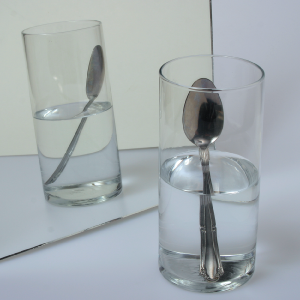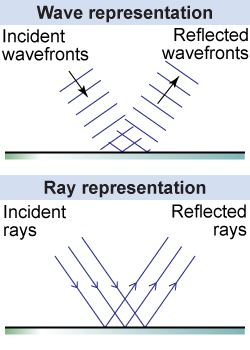|
 Intuitively, we know the spoon in the water glass in the picture is not broken at the water surface and that there is only one real glass and one reflected image. In this section we answer the question of how the illusion in the mirror is created. In the next chapter, on refraction, we will address the illusion of the broken spoon.
Intuitively, we know the spoon in the water glass in the picture is not broken at the water surface and that there is only one real glass and one reflected image. In this section we answer the question of how the illusion in the mirror is created. In the next chapter, on refraction, we will address the illusion of the broken spoon.
Consider the spoon as the object. The object is the real thing made of matter that reflects light from the room into your eye. The image in the mirror is an illusion created by changing the direction of light rays so that they appear to come from behind the mirror. To understand how this happens we use ray diagrams. Ray diagrams describe how light gets from the object to your eye and how images are formed. 
|
Light rays and ray tracing
|
 Light can be represented in different ways including wavefronts and light rays. The wavefronts of visible light are so close together, typically 5×10−7 m, that wave-front diagrams are only useful when the size of something in the system is similarly small. The diffraction and interference of light are phenomena that require this approach.
Light can be represented in different ways including wavefronts and light rays. The wavefronts of visible light are so close together, typically 5×10−7 m, that wave-front diagrams are only useful when the size of something in the system is similarly small. The diffraction and interference of light are phenomena that require this approach.
For the purposes of optics and images it is more instructive to represent light with rays. Light rays travel in straight lines through space and represent the direction of energy flow. You may imagine a single light ray as a laser beam that has a specific color and comes from a specific place. 
|
When light strikes a mirror, light rays show the relationship between the incident light and the reflected light. The incident ray represents light approaching the mirror. The reflected ray represents light reflected from the mirror surface. Incident and reflected rays usually have arrows to denote the direction the light travels. 
|
 Ray tracing is the process of determining the path of one or more representative light rays through an optical system. The diagram on the right shows a simple ray trace of three rays passing through a lens, reflecting off a mirror, and being observed. Note that the observer looks through the system yet the ray diagram is drawn from the side. Drawing from the side is necessary because the sizes and positions of objects and images are best represented from the side. As we will see later, the intersection of multiple light rays (drawn from the side) indicates where an image may be formed.
Ray tracing is the process of determining the path of one or more representative light rays through an optical system. The diagram on the right shows a simple ray trace of three rays passing through a lens, reflecting off a mirror, and being observed. Note that the observer looks through the system yet the ray diagram is drawn from the side. Drawing from the side is necessary because the sizes and positions of objects and images are best represented from the side. As we will see later, the intersection of multiple light rays (drawn from the side) indicates where an image may be formed. 
|
Where can light rays change direction?
 |
Light rays, like any other wave, change directions at the boundaries between media. For example, light will change direction when it goes from water to air. Light can bounce back by reflection or can change angle by refraction as it is transmitted. 
|

